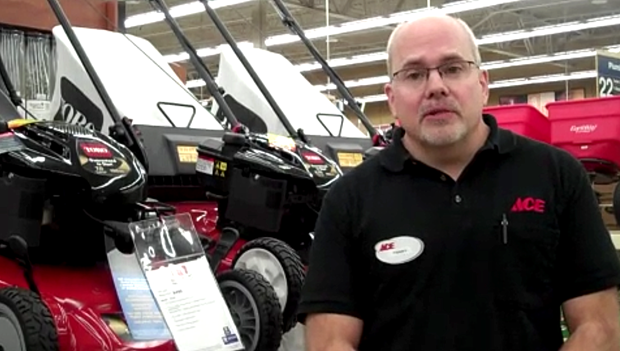You don't the permission to view this video
To keep your lawnmower’s engine running all season long, make sure to take some time to keep in maintained. In this video, we’ll teach you the proper preventive maintenance that every mower needs to keep it running like a well-oiled machine.
It happens every year without fail. It’s a gorgeous Saturday afternoon, and you’re planning to watch the big game as soon as you mow the yard. The mower is all gassed up, it’s on the right setting, but when you reach down and pull the cord—you guessed it—that familiar sound of nothing happening. Well you can forget about the game, because for the next hour you won’t be mowing … you’ll be trying to figure out what’s wrong.
Now is the time to do some preventive maintenance on your mower’s engine. The four areas you need to check include the spark plug, the air filter, the fuel, and, if you have a four-cycle engine, the oil. Our mower is what’s called a 2-cycle mower, which means the oil and gas are mixed together, combining two of these steps. Therefore, we don’t have to change the oil. For more information on the differences between 2-cycle and 4-cycle engines, see our list of Frequently Asked Questions specific to this video.
Let’s start with the air filter. You may want to lay a tarp down to protect the floor if you are working in a garage. Some mower engines have paper filters, while others, like ours, have a sponge filter. First remove the filter from the filter housing. You may need to consult the user’s manual to locate the filter compartment. If your mower has a paper filter, you should replace it. If it has a sponge filter, you can either replace it or clean it according to the manufacturer’s instructions. After cleaning it, or if you’re installing a new one like we are, you will need to lubricate it with oil, which helps remove fine dust particles that can be harmful to your engine.
Now it’s time to check the spark plug. One handy tool for removing spark plugs is this spark plug socket wrench, which you can purchase at your local independent home improvement retailer. They’ll even help you find the right replacement plug compatible with your mower. Just be sure to note your mower’s make and model number before you go. Simply unscrew the plug and check for excessive wear. You can sure see a difference between an old one and a new one. It’s a good idea to replace the spark plug every year, which will help your engine run more efficiently.
The last step if to make sure you fill the gas tank with fresh fuel, which means removing any existing fuel from the tank that was left over from last year. Old fuel in the tank is probably the leading cause of mower starting failure.
Following the manufacturer’s instructions, at the end of last season we ran the mower out of fuel the last time we mowed so the fuel wouldn’t get stale over the winter. If there is still fuel in your tank from last season, make sure you remove it from the tank according to the manufacturer’s instructions and dispose of it by taking it to a hazardous waste recycling center in your community.
The same holds true for any stale fuel in your gas can left over from last winter. Gasoline breaks down over time, which can damage your mower’s engine. Always note when you last filled up your gas can by writing the date you filled up a piece of tape. If you will be storing fuel for a prolonged period of time, it’s always a good idea to add a fuel stabilizer to your gas, which prevents this breakdown from occurring. Also, if you’re gas can is several years old, it’s probably time for a new one.
If your mower has a 2-cycle engine, add the appropriate amount of 2-cycle engine oil to your gas can, following the manufacturer’s instructions.
If you don’t use much gas, the easiest way to keep your fuel fresh is to use a smaller gas can. While it may require more frequent trips to the gas station, it will help ensure that the fuel in your mower’s engine is always fresh.
There you have it. Now you can be sure you’ve done everything you can to help your mower’s engine run like a top all season long.
If you have questions about this or any other home improvement project, be sure to read our list of Frequently Asked Questions for this video. And be sure to print out our Project Instructions, which includes a Tools and Materials checklist, before visiting your local independent home improvement retailer. That’s where you’ll find all the products and helpful advice to complete your project. If you’re not sure where to find your local store, check out our Store Locator.
Good luck with your project and thanks for watching.
Steps
- 1.
Lay down a drop cloth if you're working in the garage.
- 2.
Air filter: For a paper filter, replace with a new one.
- 3.
Air filter: For sponge filters, replace or clean it. If replacing, lubricate it with oil before placing it in.
- 4.
Use a spark plug socket wrench to remove the spark plug.
- 5.
If your spark plug looks worn down or is older than a year, replace it with a new one.
- 6.
Screw the spark plug back in using the spark plug socket wrench.
- 7.
Replace the old fuel in the gas tank with the proper new engine fuel if it hasn't been changed for a while.








Comments (0)